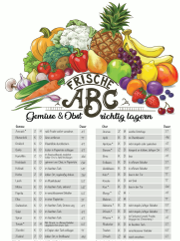What is lactic acid fermentation?
The sour taste of the sauerkraut comes from the lactic acid fermentation, which makes the cabbage durable. In an oxygen-poor environment, those naturally found on all surfaces can be found Lactic acid bacteria spread unhindered and suppress other microorganisms, so too Putrefactive bacteria. To achieve this step, the vegetables must be salted and covered in salt water and stored in an airtight container.
also read
- Canning homemade sauerkraut
- White cabbage - how to grow healthy winter vegetables yourself
- Pickling Chinese cabbage - recipe and instructions
The process is also known as "wild fermentation" because it takes place without any action. Vegetables fermented with lactic acid retain their high vitamin content and can be kept for months. In addition to white cabbage, other types of cabbage, but also almost any other vegetable, such as cucumber, carrots or radish, can be pickled with lactic acid.
A recipe for pickled white cabbage as sauerkraut
Homemade tastes best! To pickle white cabbage and make your own sauerkraut you will need the following:
- 5 kg of white cabbage
- 50 g salt (no iodized salt)
- Spices such as juniper berries or caraway seeds as desired
- Cabbage slicer or vegetable slicer
- Stone o. ä. heavy object
- Mason jars or earthenware pot
- Remove the outer leaves of the cabbage and set aside some intact leaves. Halve or quarter it (depending on the size - the pieces should be comfortable to hold when planing). The stalk still remains on the leaves because it holds them together and so planing is easier!
- Put the cabbage slicer in a large bowl and slice in all of the cabbage except for the hard stalk. You get fine stripes.
- Spread the salt over the sliced white cabbage and knead it firmly and carefully into the cabbage for several minutes until plenty of liquid has escaped.
- Mix in the spices if desired.
- Pick up boiled mason jars or a clean earthenware pot and layer the herb firmly in it. No air pockets should remain. The cabbage really needs to be pulped.
- Place an appropriately sized cabbage leaf on top of the cabbage and weigh it down with the clean stone so that the cabbage stays under the liquid.
- Seal the jar. Gases have to escape during fermentation, which is why a specially designed earthenware pot is ideal. You can also use preserving jars with a rubber ring, as these also allow some air to escape.
- Let the jars stand at room temperature for a week. They are then stored in a cool, dark room. After about four weeks, the lactic acid fermentation is complete and the sauerkraut is ready.
- Consume your homemade sauerkraut within six months. Although it can be kept for up to two years, it becomes mushy and brownish if stored for a long time.
- as free PDF file to print out on your own

The garden journal freshness-ABC
How can fruit & vegetables be stored correctly so that they stay fresh as long as possible?
The garden journal freshness ABC as a poster:
